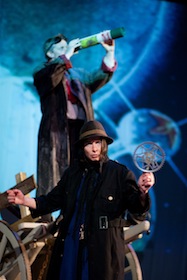There is a great simplicity in the narrative of Blue Raincoat Theatre Company’s latest play, First Cosmonaut by Jocelyn Clarke, staged this week in their resident space in the Factory in Sligo town. And this simplicity has allowed Blue Raincoat shape the story in a direction that draws on their strengths as an ensemble, resulting in a theatre of images. Directed by Niall Henry, this highly technical and rhythmical play tells the story of the life of Yuri Gagarin, which began as a small peasant farmer (he was literally five foot two in height) and who came to reach legendary heights by becoming the first man to observe the earth from space in 1961. More than this, the Soviet Union’s victory over the U.S. in the space race gestured their ideological and technological power to the world.
What has become synonymous with Blue Raincoat performers is their ability to tell a story by focussing on the body as the primary tool, influenced by their training in corporeal mime, helped too by the fact that the company has retained some of its members on a long-term basis. Founded in 1991, the company boasts itself as the only ensemble theatre company in Ireland with a repertoire base, allowing the company to return to works after a certain time with a fresh approach.
Blue Raincoat has an interest in dramatising life stories having staged writer-in-residence Malcolm Hamilton’s The Strange Voyage of Donald Crowhurst in 2003/2009 and with future plans to stage a play on the ambitions of Amelia Earhart. Modernist in trajectory, many of their works have embraced the non-natural, with recent productions of Beckett, Ionesco and the Flann O’Brien trilogy. Indeed, Blue Raincoat shares a long-term relationship with writer and dramaturg Jocelyn Clarke who adapted previously three of O’Brien’s novels for stage for the company.
Blue Raincoat’s physical style and ensemble approach to performance complements Clarke’s writing for stage. With First Cosmonaut you do not simply go to ‘see’ the play but rather you experience it in its fullest as a multisensory event. Like the group itself, the different elements of the drama work in collaboration. This is a multi-layered and engaging approach to theatre, which moves Blue Raincoat in a new creative direction.
 With a Brechtian approach, the play opens with the cast playing a fictional cast from the Smolensk region of Russia where Gagarin grew up, and introduce themselves to the audience. The play is presented in short scenes and is punctuated by a variety of performance styles. With the exception of Gagarin (John Carty), the cast (Sandra O’Malley, Ciaran McCauley, Bob Kelly, and Frances Healy) play multiple roles, and events from Gagarin’s past and present emerge. And the episodic quality of the play is carried through in the design (Jamie Varten); the crudest of equipment (cart, ladder, and umbrellas - yet again, a house prop) make the point that scientific deduction and achievement can be found in the everyday.
With a Brechtian approach, the play opens with the cast playing a fictional cast from the Smolensk region of Russia where Gagarin grew up, and introduce themselves to the audience. The play is presented in short scenes and is punctuated by a variety of performance styles. With the exception of Gagarin (John Carty), the cast (Sandra O’Malley, Ciaran McCauley, Bob Kelly, and Frances Healy) play multiple roles, and events from Gagarin’s past and present emerge. And the episodic quality of the play is carried through in the design (Jamie Varten); the crudest of equipment (cart, ladder, and umbrellas - yet again, a house prop) make the point that scientific deduction and achievement can be found in the everyday.
But it is the awe and wonder about the Earth when observed from outer space that is achieved on stage. Covering the back wall of The Factory, the use of projection, sound (Joe Hunt) and lighting (Barry McKinney), alongside the actor’s rigorous movements and spoken text enable the audience to travel dizzying heights through and above the ‘liveness’ of the clouds, journeying far up in order to look down at the stunning sculpted patterns of rock, dunes and sea that are the Earth’s natural beauty.
There are many beautiful moments in this production. When Gagarin is honoured with the highest award by a government official (Sandra O’Malley), he is handed a scroll which he takes with pride. O’Malley then removes her aviator hat and slowly pulls her shawl over her head as her body bends to age, representing Gagarin’s mother. He hands her back the award which she takes with a double sense of pride. In that tender moment, some of the audience sounded out their empathy.
Later on, Gagarin (incredibly) lands back on earth in a ploughed field three kilometres from where he had taken his first flight. A woman and a girl are farming and spot him. Both parties slowly walk to one another, the women fearful but intrigued. Gagarin narrates and enacts the meeting with these strangers, hugging and kissing them as though they were relatives.
Civilisation has always been captivated by the infinite reaches of the cosmos. The visual and aural composition of those curiosities is strategic in this production, helping us make leaps in imagination to journey with Gagarin, the everyman, through pathways in his life to outer space. With First Cosmonaut, humankind’s many feats in science and engineering are beautifully realised.
Rhona Trench is a published author and Programme Chair of the BA in Performing Arts at IT Sligo.